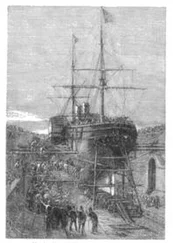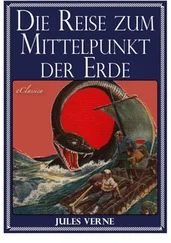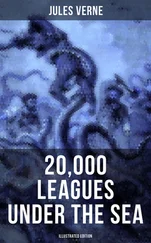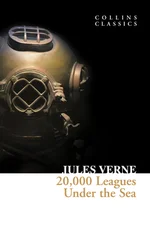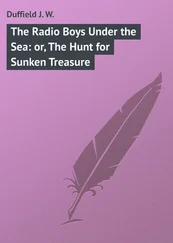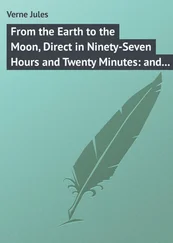Jules Verne - Twenty Thousand Leagues Under the Sea
Здесь есть возможность читать онлайн «Jules Verne - Twenty Thousand Leagues Under the Sea» — ознакомительный отрывок электронной книги совершенно бесплатно, а после прочтения отрывка купить полную версию. В некоторых случаях можно слушать аудио, скачать через торрент в формате fb2 и присутствует краткое содержание. Жанр: sf_writing, на английском языке. Описание произведения, (предисловие) а так же отзывы посетителей доступны на портале библиотеки ЛибКат.
- Название:Twenty Thousand Leagues Under the Sea
- Автор:
- Жанр:
- Год:неизвестен
- ISBN:нет данных
- Рейтинг книги:5 / 5. Голосов: 2
-
Избранное:Добавить в избранное
- Отзывы:
-
Ваша оценка:
- 100
- 1
- 2
- 3
- 4
- 5
Twenty Thousand Leagues Under the Sea: краткое содержание, описание и аннотация
Предлагаем к чтению аннотацию, описание, краткое содержание или предисловие (зависит от того, что написал сам автор книги «Twenty Thousand Leagues Under the Sea»). Если вы не нашли необходимую информацию о книге — напишите в комментариях, мы постараемся отыскать её.
Twenty Thousand Leagues Under the Sea — читать онлайн ознакомительный отрывок
Ниже представлен текст книги, разбитый по страницам. Система сохранения места последней прочитанной страницы, позволяет с удобством читать онлайн бесплатно книгу «Twenty Thousand Leagues Under the Sea», без необходимости каждый раз заново искать на чём Вы остановились. Поставьте закладку, и сможете в любой момент перейти на страницу, на которой закончили чтение.
Интервал:
Закладка:
While I was looking on this desolate scene, Captain Nemo said, in a sad voice:
"Commander La Perouse set out December 7, 1785, with his vessels La Boussole and the Astrolabe. He first cast anchor at Botany Bay, visited the Friendly Isles, New Caledonia, then directed his course toward Santa Cruz, and put into Namouka, one of the Hapai group. Then his vessel struck on the unknown reefs of Vanikoro. The Boussole, which went first, ran aground on the southerly coast. The Astrolabe went to its help, and ran aground too. The first vessel was destroyed almost immediately. The second, stranded under the wind, resisted some days. The natives made the castaways welcome. They installed themselves in the island, and constructed a smaller boat with the debris of the two large ones. Some sailors stayed willingly at Vanikoro; the others, weak and ill, set out with La Perouse. They directed their course toward the Solomon Isles, and there perished, with everything, on the westerly coast of the chief island of the group, between Capes Deception and Satisfaction."
"How do you know that?"
"By this, that I found on the spot where was the last wreck."
Captain Nemo showed me a tin-plate box, stamped with the French arms, and corroded by the salt water. He opened it, and I saw a bundle of papers, yellow but still readable.
They were the instructions of the naval minister to Commander La Perouse, annotated in the margin in Louis XVI's handwriting.
"Ah! it is a fine death for a sailor!" said Captain Nemo, at last. "A coral tomb makes a quiet grave; and I trust that I and my comrades will find no other."
| Go to Contents |
During the night of the 27th or 28th of December, the Nautilus left the shores of Vanikoro with great speed. Her course was southwesterly, and in three days she had gone over the 750 leagues that separated it from La Perouse's group and the southeast point of Papua.
Early on the 1st of January, 1863, Conseil joined me on the platform.
"Master, will you permit me to wish you a happy new year?"
"What! Conseil; exactly as if I was at Paris in my study at the Jardin des Plantes? Well, I accept your good wishes, and thank you for them. Only, I will ask you what you mean by a 'happy new year,' under our circumstances? Do you mean the year that will bring us to the end of our imprisonment, or the year that sees us continue this strange voyage?"
"Really, I do not know how to answer, master. We are sure to see curious things, and for the last two months we have not had time for ennui. The last marvel is always the most astonishing; and if we continue this progression, I do not know how it will end. It is my opinion that we shall never again see the like. I think, then, with no offense to master, that a happy year would be one in which we could see everything."
On January 2, we had made 11,340 miles, or 5,250 French leagues, since our starting-point in the Japan seas. Before the ship's head stretched the dangerous shores of the coral sea, on the northeast coast of Australia. Our boat lay along some miles from the redoubtable bank on which Cook's vessel was lost, June 10, 1770. The boat in which Cook was struck on a rock, and if it did not sink, it was owing to a piece of the coral that was broken by the shock, and fixed itself in the broken keel.
I had wished to visit the reef, 360 leagues long, against which the sea, always rough, broke with great violence, with a noise like thunder. But just then the inclined planes drew the Nautilus down to a great depth, and I could see nothing of the high coral walls. I had to content myself with the different specimens of fish brought up by the nets. I remarked, among others, some germons, a species of mackerel as large as a tunny, with bluish sides, and striped with transverse bands, that disappear with the animal's life. These fish followed us in shoals, and furnished us with very delicate food. We took also a large number of giltheads, about one and a half inches long, tasting like dorys; and flying pyrapeds like submarine swallows, which, in dark nights, light alternately the air and water with their phosphorescent light. Among the mollusks and zoophytes, I found in the meshes of the net several species of alcyonarians, echini, hammers, spurs, dials, cerites, and hyalle?. The flora was represented by beautiful floating seaweeds, laminari?, and macrocystes, impregnated with the mucilage that transudes through their pores; and among which I gathered an admirable Nemastoma Geliniarois, that was classed among the natural curiosities of the museum.
Two days after crossing the coral sea, January 4, we sighted the Papuan coasts. On this occasion, Captain Nemo informed me that his intention was to get into the Indian Ocean by the Strait of Torres. His communication ended there.
The Torres Straits are nearly thirty-four leagues wide; but they are obstructed by an innumerable quantity of islands, islets, breakers, and rocks, that make its navigation almost impracticable; so that Captain Nemo took all needful precautions to cross them. The Nautilus, floating betwixt wind and water, went at a moderate pace. Her screw, like a cetacean's tail, beat the waves slowly.
Profiting by this, I and my two companions went up on to the deserted platform. Before us was the steersman's cage, and I expected that Captain Nemo was there directing the course of the Nautilus. I had before me the excellent charts of the Strait of Torres, made out by the hydrographical engineer Vincendon Dumoulin. These and Captain King's are the best charts that clear the intricacies of this strait, and I consulted them attentively. Round the Nautilus the sea dashed furiously. The course of the waves, that went from southeast to northwest at the rate of two and a half miles, broke on the coral that showed itself here and there.
"This is a bad sea!" remarked Ned Land.
"Detestable indeed, and one that does not suit a boat like the Nautilus."
"The captain must be very sure of his route, for I see there pieces of coral that would do for its keel if it only touched them slightly."
Indeed the situation was dangerous, but the Nautilus seemed to slide like magic off these rocks. It did not follow the routes of the Astrolabe and the Boussole exactly, for they proved fatal to Dumont d'Urville. It bore more northward, coasted the island of Murray, and came back to the southwest toward Cumberland Passage. I thought it was going to pass it by, when, going back to northwest, it went through a large quantity of islands and islets little known, toward the Island Sound and Canal Mauvais.
I wondered if Captain Nemo, foolishly imprudent, would steer his vessel into that pass where Dumont d'Urville's two corvettes touched; when, swerving again, and cutting straight through to the west, he steered for the island of Gilboa.
It was then three in the afternoon. The tide began to recede, being quite full. The Nautilus approached the island, that I still saw, with its remarkable border of screw-pines. He stood off it at about two miles distant. Suddenly a shock overthrew me. The Nautilus just touched a rock, and stayed immovable, laying lightly to port side.
When I rose, I perceived Captain Nemo and his lieutenant on the platform. They were examining the situation of the vessel, and exchanging words in their incomprehensible dialect.
She was situated thus: two miles, on the starboard side, appeared Gilboa, stretching from north to west like an immense arm; toward the south and east some coral showed itself, left by the ebb. We had run aground, and in one of those seas where the tides are middling-a sorry matter for the floating of the Nautilus. However, the vessel had not suffered, for her keel was solidly joined. But if she could neither glide off nor move, she ran the risk of being forever fastened to these rocks, and then Captain Nemo's submarine vessel would be done for.
Читать дальшеИнтервал:
Закладка:
Похожие книги на «Twenty Thousand Leagues Under the Sea»
Представляем Вашему вниманию похожие книги на «Twenty Thousand Leagues Under the Sea» списком для выбора. Мы отобрали схожую по названию и смыслу литературу в надежде предоставить читателям больше вариантов отыскать новые, интересные, ещё непрочитанные произведения.
Обсуждение, отзывы о книге «Twenty Thousand Leagues Under the Sea» и просто собственные мнения читателей. Оставьте ваши комментарии, напишите, что Вы думаете о произведении, его смысле или главных героях. Укажите что конкретно понравилось, а что нет, и почему Вы так считаете.

